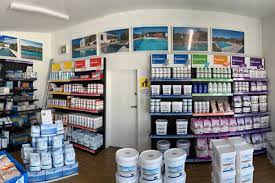
Calcium buildup on pool tiles is a common issue in Port Charlotte, Punta Gorda, North Port, Rotonda, and throughout Charlotte County. Over time, minerals from hard water and pool chemicals leave a white, chalky residue that can detract from the beauty of your pool and damage tile grout if left untreated. This guide covers effective techniques to safely remove calcium deposits and maintain sparkling, healthy pool tiles.
Why Calcium Buildup Occurs
Calcium buildup, often referred to as calcium scaling, is caused by:
- Hard water high in calcium carbonate
- Imbalanced pool water chemistry (high pH, alkalinity, or calcium hardness)
- Evaporation leaving mineral deposits along the waterline
- Frequent splashing and water circulation patterns
Left untreated, calcium deposits can become stubborn, requiring more aggressive removal techniques and potentially damaging the tile surface.
Tools and Materials Needed
- White vinegar or muriatic acid (for stubborn scaling)
- Soft scrub brush or nylon pad
- Plastic scraper (avoid metal to prevent scratching)
- Gloves and safety goggles
- Bucket for mixing cleaning solutions
- Commercial calcium remover designed for pool tiles
Step-by-Step Calcium Removal
1. Prepare the Area
- Drain pool to waterline if necessary for easier access.
- Remove any loose debris from tile surfaces.
- Wear protective gloves and goggles when using chemical solutions.
2. Gentle Cleaning for Light Buildup
- Mix a 1:1 solution of white vinegar and water.
- Apply to the affected tiles with a sponge or brush.
- Scrub gently in circular motions to avoid scratching tile.
- Rinse thoroughly with clean water.
3. Stronger Cleaning for Stubborn Deposits
- For heavy buildup, use a commercial calcium remover or diluted muriatic acid (carefully following product instructions).
- Apply with a plastic scraper or brush to loosen deposits.
- Work in small sections and rinse immediately to prevent damage to grout and surrounding surfaces.
4. Prevent Future Buildup
- Test pool water weekly to maintain proper pH (7.2–7.6) and calcium hardness (200–400 ppm).
- Use a pool sequestering agent to bind minerals and reduce scaling.
- Regularly brush the waterline tiles to prevent deposits from forming.
Local Considerations
- Port Charlotte & Punta Gorda: High humidity and frequent summer storms can accelerate calcium scaling.
- North Port: Hard water sources may require extra monitoring of water chemistry.
- Rotonda & Charlotte County: Saltwater pools also experience mineral buildup; choose products safe for salt systems.
Trusted Local Resources
- Florida Detail – Expert tile cleaning and calcium removal
- Port Charlotte Pool Services – Local pool maintenance specialists
- North Port Pool Services – Professional calcium scale prevention
- Unlimited Maniac Marketing – Tips on maintaining pristine Florida pools
Conclusion
Calcium buildup on pool tiles is a manageable problem with proper techniques and regular maintenance. By using gentle cleaning methods for light scaling and stronger solutions for stubborn deposits, homeowners in Charlotte County can keep pool tiles sparkling while protecting water chemistry and surfaces.
For professional assistance in removing calcium buildup and preventing future scaling, visit Florida Detail to connect with local pool experts.
